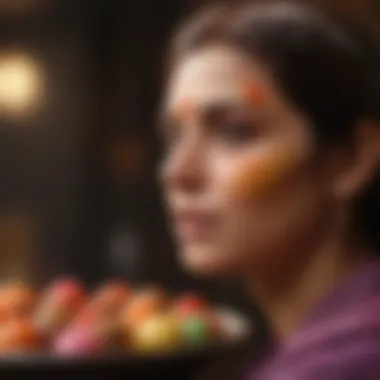Understanding Holi: Cultural Significance and Traditions


Intro
Holi is an ancient festival celebrated with great fervor, predominantly in India. This festival signifies the end of winter and the arrival of spring. Rich in cultural and historical context, Holi symbolizes the victory of good over evil, a theme deeply ingrained in various narratives and folklore. The vibrant display of colors, music, and dance during this festival not only enhances its beauty but also embodies the spirit of unity and joy among communities.
This article aims to provide a detailed exploration of Holi's cultural significance and traditions. We will look at the historical roots of the festival, its importance in contemporary society, and the diverse ways it is celebrated across different regions. By examining these aspects, readers can gain a comprehensive understanding of what Holi represents and the values it promotes.
Historical Origins of Holi
The origins of Holi can be traced back to various Hindu legends, each reflecting different aspects of life. One strong narrative is linked to the myth of Prahlada and Hiranyakashipu. This tale speaks of devotion, resilience, and the eventual downfall of evil. As the story goes, Hiranyakashipu, a demon king, was granted a boon that made him nearly invincible. His son Prahlada, however, remained devoted to Lord Vishnu, angering his father. In a legendary act of faith, Prahlada's devotion led to the king's defeat, showcasing the triumph of good over evil.
The festival also marks the arrival of spring, symbolizing renewal and the blossoming of nature. The tradition of throwing colored powders, known as Gulal, originated from this celebration of color associated with spring flowers. Moreover, Holi represents the reconciliation of conflicts, fostering an atmosphere of peace and friendship.
Cultural Significance
Holi is not merely a festival of colors; it carries deep cultural significance. It serves as an expression of social equality, where people from various backgrounds come together to celebrate. The act of applying colors transcends barriers, breaking down the walls of class, gender, and age.
Holi encourages community bonding and helps foster social harmony. It is a compelling reminder of the strength found in unity amid diversity.
This festival also emphasizes the importance of forgiveness and renewal of relationships. People often reach out to friends and family, mending old grievances in the spirit of celebration.
Diverse Traditions of Holi
Across India, Holi is celebrated with unique local customs that showcase its diversity. In the northern states, such as Uttar Pradesh, the festival is marked by traditional songs, dances, and the playful tossing of colors. In cities like Mathura and Vrindavan, reenactments of Lord Krishna's playful interactions with Radha and the gopis are common.
In contrast, in regions like West Bengal, Holi is known as 'Dol Jatra' or 'Dol Purnima,' with its own set of rituals and customs. Here, the celebration is marked by the swinging of colorful idols and community feasts.
Ending
Understanding Holi involves appreciating its rich historical roots, cultural significance, and diverse traditions. This festival stands as a testament to resilience, unity, and the eternal struggle between good and evil. It fosters connections, encourages forgiveness, and allows individuals to celebrate life in its most vibrant form.
Foreword to Holi
Holi is not merely a festival; it represents a profound cultural phenomenon that resonates through the very fabric of society, especially in India. Celebrated with fervor and enthusiasm, it marks the coming of spring and symbolizes the victory of good over evil. The significance of this event stretches beyond its immediate festivities, offering various layers for understanding.
Key aspects of Holi involve community bonding, the expression of joy, and the renewal of relationships. During this festival, people gather, share, and embrace the spirit of togetherness. The vibrant colors splashed on individuals serve not just as a celebration of spring but also signify unity amidst diversity. The act of throwing colors is a joyful expression that transcends social barriers, promoting a sense of camaraderie among participants.
A crucial consideration in understanding Holi is the way it fosters cultural identity. The customs and traditions associated with this festival vary widely across regions, yet they all encapsulate a shared ethos. From playful color fights to devotional rituals, each practice reflects local beliefs and societal norms. Thus, exploring Holi provides a lens through which to view the interactions between tradition and modernity, culture and identity.
Historical Origins of Holi
Holi has rich historical roots that weave through various texts and legends. Understanding its origins is essential for grasping the spirit and meaning of this vibrant festival. The historical dimensions of Holi signify not only cultural practices but also shared values of community and resilience.
Holi in Ancient Texts
Holi finds mention in ancient texts, which affirm its significance in Indian culture. Notable references include the Puranas and the Rig Veda. These texts provide a narrative foundation for the traditions observed today. They describe the cyclical nature of seasons and the themes of renewal found in Holi.
Key Elements in Ancient Texts
- Seasonal Change: The arrival of spring is celebrated through colors and festivities.
- Mythological Context: Stories framed in these texts illustrate the triumph of good over evil.
Understanding these elements is not just about historical accuracy. It helps in valuing Holi as a symbol of hope and continuity. These texts serve as a guide, presenting cultural heritage preserved through generations.


Legends and Myths
Holi is also deeply rooted in popular legends that contribute to its narrative and cultural significance. Two prominent stories are about Prahlada and Holika, and the love story of Radha and Krishna.
Prahlada and Holika
The tale of Prahlada and Holika serves as a narrative foundation in the celebration of Holi. Prahlada was a devoted follower of Lord Vishnu, while Holika had evil intentions.
- Key Characteristics: This story highlights unwavering faith and the protection of good against malign forces.
- Cultural Impact: The burning of Holika symbolizes the victory of devotion and equity.
One unique feature of this tale is the emphasis on faith. It resonates with many participants of Holi, offering them encouragement during difficult times. The celebration thus becomes not just a festival, but also a reminder of resilience.
The Legend of Radha and Krishna
The second narrative centers on Radha and Krishna, symbolizing love and joy. Their playful interactions during Holi are celebrated widely.
- Key Characteristics: The story represents love, compassion, and connection among people.
- Cultural Importance: This legend reinforces the spirit of togetherness, core to Holi celebrations.
The unique feature here is the portrayal of divine love expressed through celebration. This aspect enriches Holi by making it a festival of community and connection, appealing to individuals seeking deeper social bonds.
Overall, the legends of Holi provide valuable insights into its cultural significance. They transform the festival into an embodiment of shared human experiences, ensuring that participants feel a deeper connection to its roots.
Cultural Significance of Holi
Holi is not merely a colorful festival; it holds profound cultural significance that extends beyond the act of celebrating the arrival of spring. This section explores two key aspects: its symbolism of renewal and new beginnings, and its role as a celebration of love and friendship. Through these lenses, we can comprehend how Holi enriches social fabric and fosters connection between individuals.
Symbol of Renewal and New Beginnings
Holi, celebrated at the end of winter, symbolizes the renewal of nature and the arrival of fresh beginnings. As spring emerges, flowers bloom and trees regain their foliage. Holi aligns with this natural transformation, emphasizing the idea of letting go of past grievances. The colorful powders used during the celebrations reflect vibrancy and consistency with the joyous spirit of life.
During this festival, participants engage in throwing colors at each other, representing the discarding of old conflicts and embracing positivity. This act encourages people to forgive and start afresh. The vibrant colors not only enhance the beauty of the surroundings but also create an environment conducive to harmony and peace.
Holi highlights the cyclic nature of life, illustrating that new beginnings are possible, regardless of past difficulties.
Celebration of Love and Friendship
Holi is also a profound celebration of love and friendship. The connections formed during this festival cut across social boundaries. People come together in revelry, fostering relationships that transcends everyday differences. It is a time when childhood memories resurface, and friendships are rekindled.
In various regions, Holi is celebrated with different customs that emphasize love and unity. In North Indian celebrations, for instance, the playful banter between friends and family highlights a spirit of camaraderie. In contrast, certain South Indian customs may focus more on household gatherings, but the essence remains the same – to celebrate togetherness.
In contemporary society, Holi has adapted to include diverse communities, demonstrating its universality. As people partake in this festival around the world, it cultivates a sense of belonging and shared joy. The act of applying colors becomes a physical manifestation of love, joy, and friendship.
Thus, Holi stands as a profound reminder that love is essential in human relationships, promoting social cohesion and understanding among diverse groups. Its cultural significance is not limited to its historical roots but thrives in its capacity to transform societal dynamics today.
Traditional Practices During Holi
Traditional practices during Holi play a crucial role in the festival, emphasizing community bonding and cultural heritage. These practices are not just acts of celebration but are steeped in meaning that enhance the spirit of Holi. They foster connection, bring joy, and create an atmosphere of unity among participants. This section dives into the key traditional practices, each with its specific elements and cultural relevance.
Throwing Colors
The act of throwing colors is perhaps the most iconic feature of Holi. Participants use powders known as gulal, made from natural ingredients, to create a vibrant spectacle. This practice represents the joy of spring and the arrival of a new season. Throwing colors is significant as it breaks down social barriers, allowing people of different backgrounds to come together. The cheerful chaos of colors is an expression of freedom and jubilance. Importantly, the colors used today often come from organic sources, lessening environmental impact, yet maintaining the joyful essence of the celebration.
Bonfires and Rituals


Bonfires form another integral part of Holi. On the eve of the festival, communities gather to perform a ritual called Holika Dahan. This ritual not only serves as an act of worship but symbolizes the victory of good over evil. As the flames rise, people participate in traditional songs and collective celebrations, creating a sense of communal identity.
Holika Dahan
Holika Dahan plays a significant role in the observance of Holi. This ritual involves lighting a bonfire to commemorate the defeat of the demoness Holika. The flames are not merely for warmth or light; they represent purification and the eradication of negativity. The key characteristic of Holika Dahan is its communal aspect; it brings families and neighborhoods together in shared observance, reinforcing social bonds. Each participant contributes to the flames, symbolically casting away their troubles and desires.
A unique feature of Holika Dahan is the sharing of sentiments and prayers during the event. People often gather around the fire, chanting mantras and offering their thanks. This aspect of Holika Dahan becomes a moment of reflection and connection, offering a blend of spiritual and social benefits.
Festive Foods and Drinks
Culinary delights are synonymous with Holi celebrations, adding a rich layer to the festivities. Two popular items stand out during this time: Gujiya and Bhang. These foods not only tantalize the taste buds but also enhance the celebratory spirit of the festival.
Gujiya
Gujiya is a sweet dumpling filled with khoya and dry fruits, often shaped into a crescent. This indulgent treat is a staple during Holi, symbolizing the sweetness of relationships. The key characteristic of gujiya is its delightful flavor, which invites sharing among family and friends. Its popularity during the festival serves to strengthen connections and creates a sense of unity through shared enjoyment. Its unique feature lies in the way each household has its own recipe, leading to a delightful variety.
Bhang
Bhang, a drink made from the leaves of the cannabis plant, carries cultural significance during Holi. Traditionally consumed to elevate the celebratory atmosphere, Bhang also represents liberation from constraints. Its key characteristic is its psychoactive properties, which can deepen the joyous experiences associated with Holi. While Bhang is a cherished part of the celebration for many, it's essential to discuss its consumption responsibly. It can lead to unpredictable reactions, making it both a beneficial and controversial choice for the festival. Its unique feature is the diverse ways of preparation, from drinks to sweets, allowing communities to explore traditional flavors.
Holi is not just about vibrant colors and delicious foods. It's a deep-rooted tradition that fosters community and shared experiences.
Regional Variations of Holi
The significance of regional variations in Holi cannot be understated. This festival, steeped in tradition and culture, changes its face across different parts of India and beyond. Each region adds unique flavors, practices, and meanings to the celebration, contributing to a richer understanding of Holi as a whole. These variations enhance cultural diversity, fostering appreciation for different customs while promoting unity through shared celebrations. The distinct expressions of Holi also serve to highlight local identities, making the festival unique yet collectively significant.
Holi in North India
In North India, Holi is celebrated with exuberance and fervor. The timing, usually in March, aligns with the arrival of spring. The people gather in large numbers for communal celebrations, often starting days before the main festival. The throwing of colors is a central activity, representing joy and the arrival of vibrant life. Cities like Vrindavan and Mathura, linked to the legends of Radha and Krishna, witness particularly grand festivities. Holi in North India emphasizes community bonding and the joyous expression of relationships among friends and families.
Holi in West India
Goa
Holi in Goa takes on a more laid-back yet colorful atmosphere, showcasing its unique blend of cultures. The beach parties and the fusion of Hindu and Christian traditions make it distinct. People participate in music, dance, and vibrant gatherings, focusing on celebration rather than ritual. The key characteristic of Goa's Holi is its emphasis on inclusiveness, attracting a diverse crowd from both local and international communities. The distinct feature of Goa’s Holi celebrations involves the unique incorporation of seafood and other local delicacies into festive meals, though this can be a point of debate among purists.
Rajasthan
Rajasthan’s Holi is marked by historical grandeur. The festivals often include folk songs and dances, with traditional processions that offer a glimpse into the state's rich heritage. The key characteristic is its blend of artistry, as local art forms are prominently showcased during celebrations. The vibrant colors, accompanied by the traditional sweets and dishes, create a festive atmosphere. Rajasthan's unique feature during Holi is the quite popular 'Lathmar Holi' in Barsana. Here, women playfully chase men away with sticks, symbolizing a playful take on courtship, adding a light-hearted yet meaningful dynamic.
Holi Celebrations in South India
While not as widely celebrated, Holi in South India carries its significance. The festival is recognized primarily in states like Karnataka and Tamil Nadu, where local traditions blend into the celebration. In some places, visual displays of color and traditional songs echo through the streets. The celebrations are often quieter but still impactful, focusing on community gatherings and familial bonds. Some regions incorporate traditional foods associated with Holi, highlighting local culinary practices and customs connected to the festival.
Holi in International Context
The Global Celebration
The global celebration of Holi showcases its adaptability across borders. Cities around the world, like London, New York, and Sydney, host large-scale Holi festivals. These events often attract diverse participants, further enriching the festival's significance. The emphasis on joy, inclusion, and the spirit of unity transcends geographical boundaries. Such celebrations provide a platform for cultural exchange and educational opportunities about Indian traditions to those unfamiliar with them. However, commercial aspects can sometimes overshadow the cultural significance.
Adaptations in Different Cultures
The adaptations of Holi in various cultures reveal its global appeal. Countries like Nepal and Mauritius hold their own unique interpretations that consist of local elements blended with traditional Hindu practices. This cultural fusion enriches the festival, allowing it to grow and evolve. Importantly, these adaptations often maintain the essence of Holi, focusing on themes of renewal and togetherness, though they may diverge in practices and festivities.


This global spread highlights how Holi fosters a sense of community not just in India but across the world.
Impact of Holi on Society
Holi is more than just a festival; it is a social phenomenon that leaves a significant mark on society. Celebrated widely, its impact extends beyond the mere act of throwing colors. The festival fosters a sense of community, breaks down social barriers, and encourages a flow of cultural exchange.
Fostering Community and Togetherness
The festival plays a crucial role in creating a sense of unity among diverse groups. People's participation transcends age, caste, and socioeconomic status. On this day, individuals come together to celebrate, forgetting their differences.
During Holi, communities organize events in local parks or public spaces where people gather. These gatherings encourage bonding, as families and friends share festive foods and drinks. Moreover, festivities do not limit themselves to just the immediate community; people often travel to see extended family, reinforcing connections.
- Community Engagement: Local organizations or community centers often play an important role in organizing Holi celebrations. These events may include music, dance, and cultural performances.
- Environmental Awareness: In recent years, many communities have started promoting eco-friendly colors and practices to celebrate Holi sustainably.
Celebrating Holi highlights the importance of togetherness. It reminds everyone that despite life's challenges, moments of joy can bring people closer.
Encouraging Cultural Exchange
Holi serves as an excellent opportunity for cultural exchange. In today's globalized world, it is not just limited to India. Many diasporic communities celebrate Holi outside of India, such as in the United States, Canada, and the United Kingdom. As these communities engage with locals, they introduce traditions related to Holi, creating an enriching experience.
- Adaptation of Traditions: In various countries, local customs are incorporated into Holi celebrations. For example, in some places, it is celebrated alongside local spring festivals, combining different cultural practices.
- Culinary Influences: The exchange also happens through food. The sweet Gujiya and refreshing Bhang become a part of Holi celebrations in many countries, melding Indian recipes with local flavors.
Through these interactions, Holi becomes a medium for understanding and appreciation. It emphasizes the need for cultural dialogue in a world that often feels disconnected.
Holi transcends geographical boundaries, bringing together people through shared experiences and enjoyable moments.
Contemporary Interpretations of Holi
Holi has evolved significantly over the years, reflecting changes in societal norms and cultural practices. Today, interpretations of Holi embody not only traditional elements but also modern adaptations shaped by globalization and technology. This section explores the facets of contemporary interpretations of Holi, highlighting its relevance in the current landscape and the benefits and challenges that accompany these changes.
Modern Celebrations and Events
In urban areas, Holi celebrations have transformed to accommodate larger crowds and more diverse participants. Organized events in parks and community centers draw people from various backgrounds, creating a vibrant atmosphere replete with music, dance, and, of course, colors. Major cities often host large-scale festivities, like the Holi Festival of Colors, which attracts attendees from different parts of the country and even tourists from abroad. These celebrations use social media extensively for promotion and to share experiences in real-time.
Attendees now also enjoy a mix of traditional and modern aspects. While the throwing of colored powders remains the central theme, many events incorporate food stalls featuring fusion dishes. The presence of live DJs and performers has brought a fresh flavor to the festivities, moving away from the more traditional folk songs that once dominated.
More and more, people are embracing themed parties, adjusting age-old practices to meet the expectations of younger generations. This modern approach has injected a new life into the festival, making it relevant to those who might otherwise feel disconnected from traditional celebrations. Thus, Holi remains a symbol of joy and unity, even as it adapts to contemporary culture.
Changing Dynamics and Challenges
The modernization of Holi is not without its challenges. With the increase in attendees, there is a growing concern about environmental impact. The use of synthetic colors, while vibrant, often leads to harmful consequences for the environment. As awareness rises, many organizations are promoting eco-friendly alternatives. Organic powders are gaining popularity as people become more conscious of the ecological footprint of their celebrations.
Additionally, there are societal challenges to consider. A diverse range of participants sometimes leads to misunderstandings or clashes between various cultural norms and practices. Ensuring inclusivity while respecting traditions can be difficult. Events need to be mindful of a wide array of customs to create a safe space for everyone.
In urban settings particularly, commercial interests can overshadow the cultural significance of Holi. The emphasis on profit may dilute the essence of the festival, shifting the focus from celebration to consumerism. However, many community leaders and cultural advocates are pushing back against this trend, striving to keep the spirit of Holi alive amidst modern pressures.
Finale
The conclusion serves as an essential part of the article on Holi, tying together the various elements discussed throughout. It offers a chance to reflect upon the cultural depths of this vibrant festival and the broader implications for society today.
In this article, we examined the historical origins of Holi, tracing its roots and its evolution over centuries. Understanding these origins enhances appreciation for the way Holi has developed, mirroring changes in societal dynamics over time. The traditions that accompany Holi, from throwing colors to preparing festive foods, are more than mere rituals; they embody values of community, love, and renewal.
Highlighting the cultural significance of Holi, we noted how it stands as a symbol of hope and joy. This festival encourages individuals to set aside differences, fostering an atmosphere of inclusivity. As a vibrant expression of cultural identity, Holi transcends geographical boundaries, influencing celebrations worldwide.
Additionally, we discussed the impact of modern interpretations and evolving challenges related to Holi. As society progresses, traditional celebrations often adapt, creating a blend that respects heritage yet embraces change. The insights gained emphasize the importance of continuity in cultural practices while also recognizing the need for adaptability.
In summary, the narrative of Holi is a rich tapestry woven from history, tradition, love, and community. As we engage with these concepts, we gain a deeper understanding not only of the festival itself but also of human connections that bind us. Recognizing these interconnections encourages a more thoughtful and enriching celebration of Holi, allowing everyone to participate meaningfully in a festival that unites diverse communities.
"Holi is not merely a festival; it is a celebration of life, forming bonds through joy and color."







